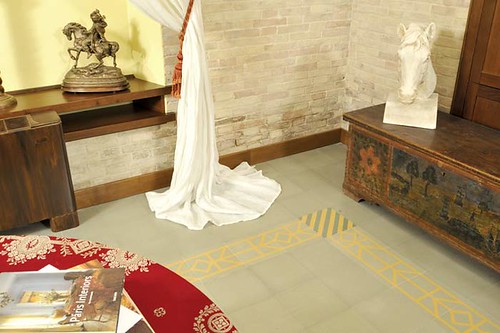The history of terrazzo tiles: Part III
Cement-based agglomerates composed of prefabricated elements were one of the most important new fields of development in the world of agglomerates in the 20th century.
In Italy the technique of compacting minerals to produce flooring was and is a specialization dating back several centuries and connected to the most ancient and precious forms of early Christian Greek mosaics.
In the early 20th century, the exceptional skills of some craftsmen, trained at excellent professional schools, helped develop and continue, later also in the industry, the cultural wealth of flooring art amassed over the centuries.
Prefabrication added not only quality but also and especially an almost unlimited durability to agglomerates. It also enabled production processes, such as “mixture vibration”, “mixture compression” and “controlled seasoning”, which were not possible with techniques of the past.
As the years went by and techniques improved, the manufacture of marble chip floor tiles was adapted to new requirements of the market. A process began to make small and large marble chip floor tiles not only on an artisanal but also on an industrial scale and the sector developed using ever more advanced technologies.
The design skills and mastery of Italian manufacturers, the variety and the beauty of Italian marbles, the plasticity and best hydraulic binder in the world were the elements that made a great many varieties and types of flooring viable and led Italy to become world leader in the manufacture of marble chip floor tiles.
collezione ruggeri-mannucci Arch. Parisi design
All horizontal surfaces are finished in wood and Grandinetti terrazzo tiles. The mosaic floor of the main room has been developed starting from custom ornamental ceiling fresco transferred on the tiles 60×60 cm format. The installation was curated taking account of the combination of different materials: the results show in addition to the obvious aesthetic merits versatility and ease of implementation.
Collection can be visited, with the entrance in Via Gioberti 5 – Fabriano (An), on Saturday and Sunday, from 17 to 19.
http://www.fondazionecarifac.it/
The history of terrazzo tiles: Part II
Marble grit floor tiles were first seen at the end of the 19th century in parallel with the invention of cement, used as a binder for the chips obtained from crushing the most varied types of marble (hence the vast range of colours that characterise the production of marble grit floor tiles) to form the mixture subsequently pressed into moulds.
“Pastina”, on the other hand, may be defined the progenitor of marble grit floor tiles, given the vast number of 19th and early 20th century buildings and houses with this type of flooring. It is characterised by much finer grinding of the marble than for marble chip and by subsequent mixing with hydraulic binders and natural oxides.
Design-wise, stylistically and aesthetically, marble grit floor tiles were undoubtedly inspired by the magnificent Venetian mosaic floors that were entirely made in situ and still today adorn the most beautiful villas in Italy (just think of the Palladian villas). So much so that, in the most simplistic way, marble grit floor tiles may be considered a kind of “prefabricated” Venetian mosaic floor.
Adornments were instrumental to enhancing marble grit floors. Greek fretwork, edging and rugs embellished the plain backgrounds.
These decorations, which are now classics, sprang up in the early decades of the 20th century and still today are divided into “geometrical” and “floral” patterns following the two dominating cultural trends of the time: Art Nouveau (1910-1920), in Italy better known as “floral”, and futurist (1930-1940) leaning towards movements and geometries.
Style under your foot
The classic pavement is reinvented: star, herringbone or Escher.
See the full article published in “AT casa” by Corriere della Sera and “Case da abitare”:
The history of terrazzo tiles: Part I
The Venetian mosaic or beaten floor is named after the lagoon city where it reached the zenith of its development and splendour. Its progenitors date back to the beginning of Greek flooring history when floors were made of river stones set in a bed of lime and clay. Later, particularly in the days of the Romans, this quite simple type of flooring was substituted with various flooring techniques – including the technique of interest to us – opus signinum, which, it seems, also went by the name of pavimentum barbaricum.
In Italy the opus signinum was made with a mix of potsherds and lime which produced a pinkish colour. That is why it was also called pavimentum testaceum. If shards of marble were also added to the mixture it was called opus segmentatum. Examples of segmented floors dating back to the 1st century AD are found in the deepest layer between the basilica and the bell tower of Aquileia.
Already in ancient Rome one could see pavimenta [from the Latin pavimentum a hard floor] and a special type of paving, so-called lithostrota – ancient mosaic floors made by interweaving small stones.
Pavimenta, on the contrary, were beaten floors. It would appear that the root of the word is pav- from Latin pavire “to beat hard”, as explained by Pliny (Nat. Hist., XXXVI, 185).
These floors were made of lime using a technique and materials similar to those of plasters.
Mosaic floors (opus tesselatum or sometimes also vermiculatum) reached the height of perfection towards the end of the Roman Empire in the early Christian and Byzantine ages. In this period, in fact, with the advent of Christianization mosaics prevailed over painting. Later, with the barbaric invasions this art died out, but nonetheless, it continued to be handed down in ways not yet clear. Credit for the rediscovery and reappraisal of ornamental flooring is especially due to the craftsmen of Friuli, who developed mosaic floors using multi-coloured pebbles collected from the beds of the Meduma, Tagliamento and Cellina rivers and which they called beaten floors. The mosaic floor makers, attracted by the beginnings of trade and flourishing building activities in the lagoon centre, brought their expertise to Venice where they developed to such an extent as to become members of the art guilds from as early on as 1586.

















